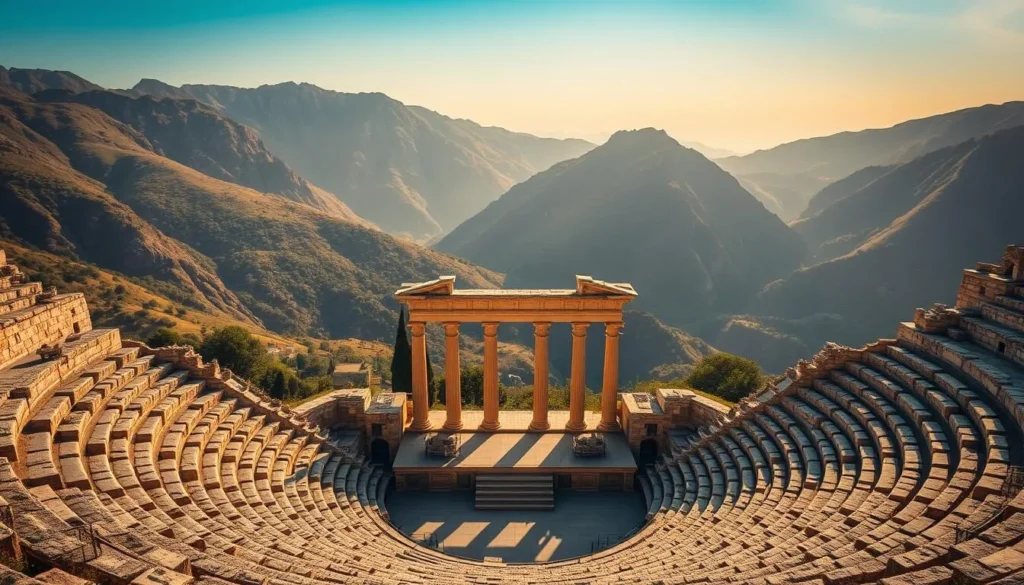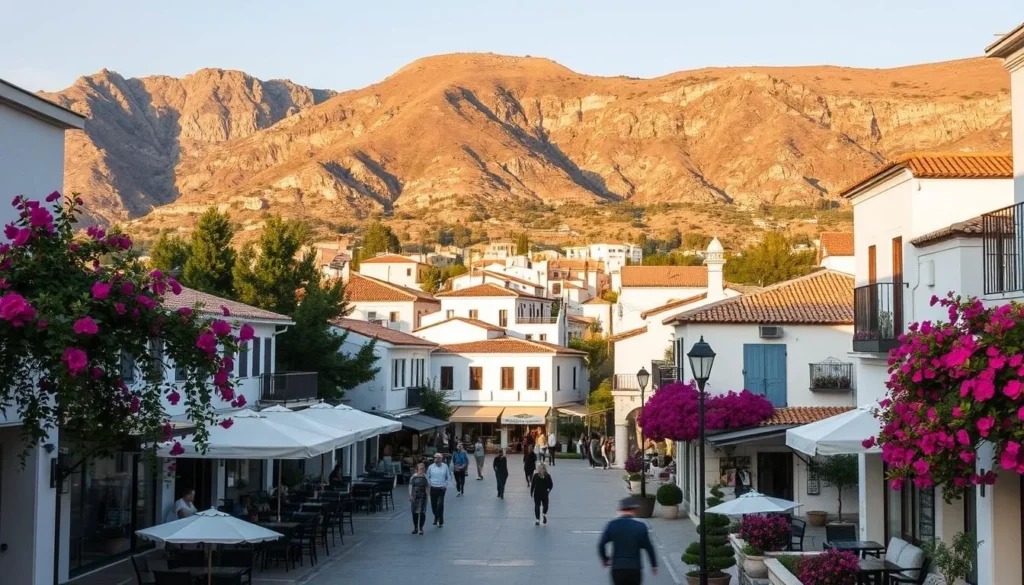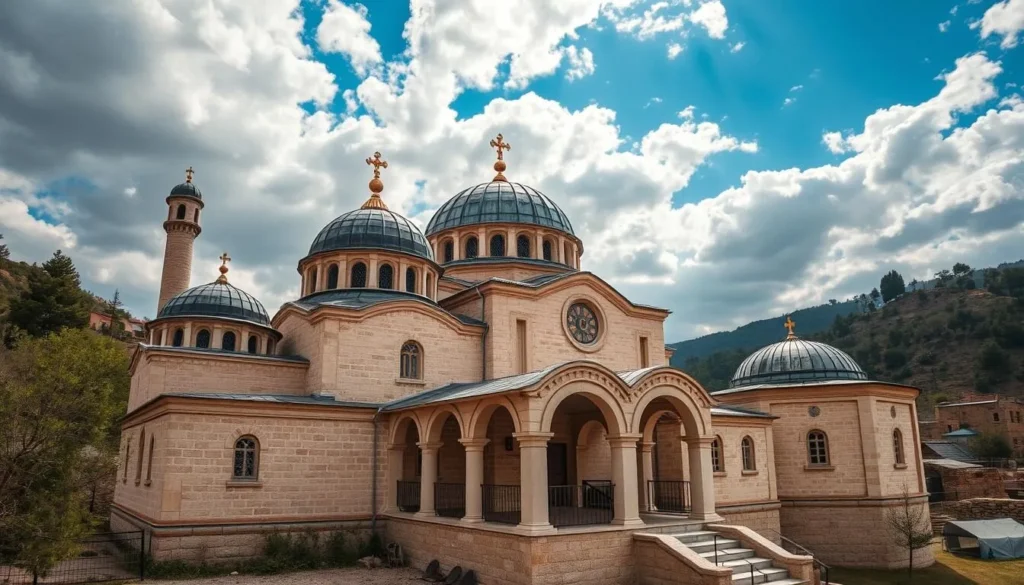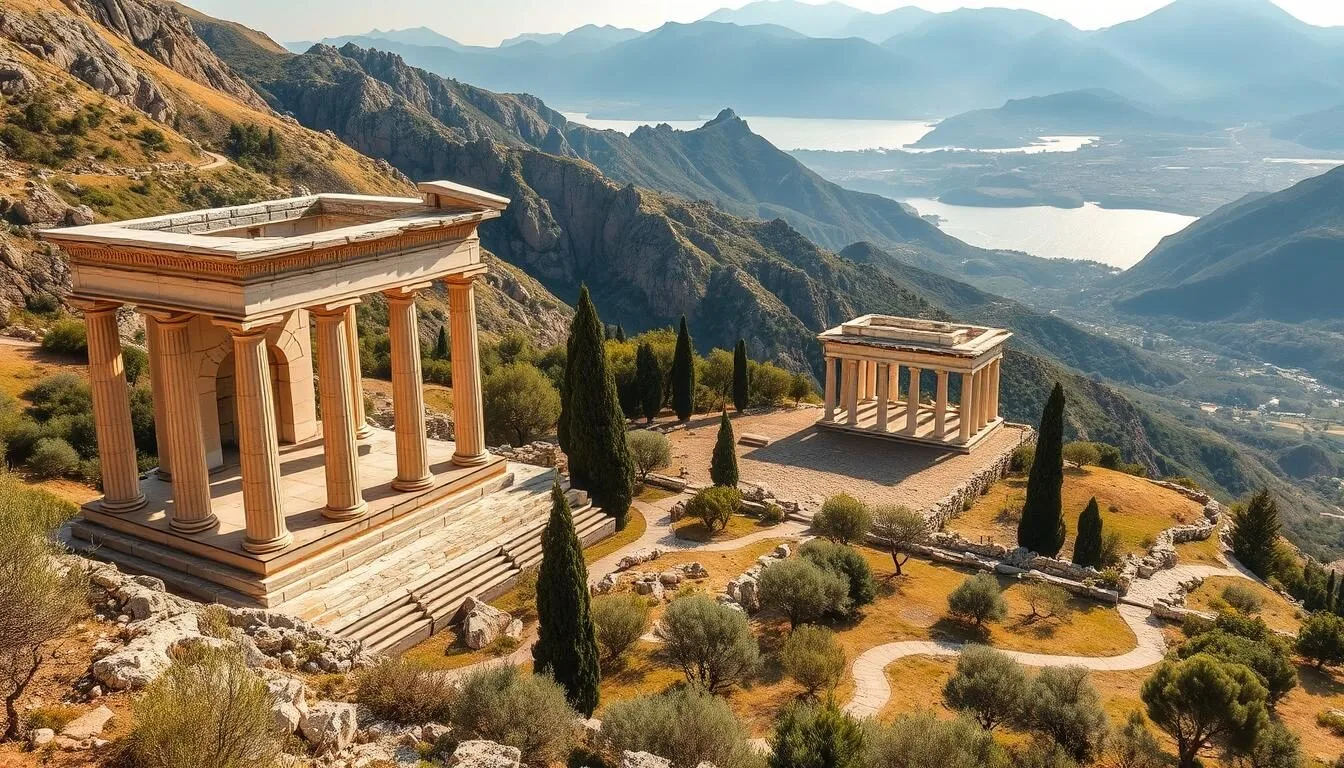✓ Accommodations✓ Flights✓ Rental Cars✓ Tours & Activities
Imagine standing at the navel of the world, a place where ancient Greeks once sought divine guidance. Delphi, a spectacular archaeological site, was considered the center of the universe in ancient times. According to myth, it was here that two eagles released by Zeus met, signifying its importance.
You are about to embark on a journey through this historical site, exploring its significance, top attractions like the Temple of Apollo and the Archaeological Museum, and learning how to plan your visit, whether as a day trip or a longer stay.
This comprehensive guide will help you make the most of your experience in Delphi, providing insider tips and practical information to enrich your travel.
Discovering the Ancient Center of the World
As you step into Delphi, you’re walking into a place that was once believed to be the navel of the earth by the ancient Greeks. This ancient site, nestled on the slopes of Mount Parnassus, has been a hub of historical and religious significance for millennia.
The Historical Significance of Delphi
Delphi was considered the center of the world by the ancient Greeks, who believed that Zeus’s two eagles met there, marking it as the “omphalos” or navel of the earth. The Temple of Apollo, built on the south-western slope of Mount Parnassus, was a major religious center where the Pythia, or Oracle of Delphi, would provide prophecies to those seeking guidance.
The control over Delphi and the Pythian Games was highly contested, leading to a total of four Sacred Wars between Greek city-states. This highlights the importance of Delphi not only as a religious site but also as a political and cultural hub in the ancient Greek world.
Planning Your Visit to Delphi
Delphi is a UNESCO World Heritage site, attracting thousands of visitors each year. The best time to visit is from April to September when the weather is ideal for exploring the outdoor ruins. To plan your visit, you can reach Delphi from Athens in approximately 2.5 hours by car or bus.
You can choose to explore the site independently or join a guided tour to gain deeper insights into its historical significance. Allocate a few hours to fully appreciate the site’s majesty and historical importance.
Explore the Temple of Apollo and the Oracle
The journey to the heart of Delphi’s archaeological site is a walk through history, culminating at the majestic Temple of Apollo. As you follow the ancient path, known as the “Sacred Way,” you’ll pass through votive offerings from powerful city-states like Athens, Sparta, and Thebes. The Treasuries, small yet elegant buildings, housed dedications made by Greek city-states to Delphi and Apollo. Notable among these is the Siphnian Treasury, the oldest religious structure in mainland Greece made entirely of marble, dated to the 6th century BC.
The Sacred Way and the Omphalos
As you walk along the Sacred Way, you’ll be surrounded by historical significance. The path leads you to the Temple of Apollo, the central structure of the sanctuary. Nearby, the Omphalos stone, or the “navel of the world,” marks Delphi as the center of the earth according to Greek mythology. This symbolic stone is a must-see, offering a glimpse into the ancient world’s perception of Delphi as a sacred place.
The Pythia and Ancient Prophecies
The Temple of Apollo was home to the Pythia, the Oracle priestess who delivered prophecies that shaped the ancient world’s political landscape. Seated on a divine tripod in the adyton of the temple, the Pythia entered trances, possibly induced by natural gases, to convey the words of the god Apollo. These cryptic prophecies, interpreted by priests, influenced major historical events, including wars and the rise and fall of leaders. Exploring the stories behind these prophecies offers a fascinating glimpse into the role of the Oracle in ancient Greek society.
As you explore the Temple of Apollo and the surrounding sanctuary, you’ll uncover the rich history and significance of this ancient site. The ruins of the temple, along with the Sacred Way and the Omphalos, provide a unique window into the spiritual and cultural practices of the ancient Greeks. By understanding the importance of the oracle and the role it played in shaping history, you’ll gain a deeper appreciation for Delphi’s status as a center of ancient Greek culture.
Marvel at the Ancient Theater and Stadium
Perched above the Temple of Apollo, the Theater of Delphi is an archaeological gem waiting to be discovered. As you climb above the temple, you’ll be rewarded with an excellent panoramic view of the unique landscape.

The Theater of Delphi
The Theater of Delphi is where the musical and dramatic games of the Pythian Games took place. This remarkably well-preserved ancient theater could seat up to 4,500 spectators for dramatic and musical performances. As you explore the theater, you’ll be treated to breathtaking views of the sanctuary below and the stunning valley beyond, making it one of the best photo spots in Delphi.
The Ancient Stadium and Pythian Games
From the theater, the path leads to the Delphi Stadium, the venue for the Pythian sporting events. The stadium, one of the best-preserved from antiquity, could hold up to 7,000 spectators and featured a 177-meter-long track where athletes competed in foot races, wrestling, and other events. You can still see the stone starting blocks for runners and inscriptions warning spectators not to remove ceremonial wine from the premises.
- Discover the history and significance of the Pythian Games, which were second only to the Olympics in importance in ancient Greece.
- Explore the ancient Stadium and Theater, and learn about the athletic, musical, and dramatic competitions that took place there.
- Enjoy the stunning views from the theater and stadium, and take in the rich history of the site.
Visit the Sanctuary of Athena Pronaia
The Sanctuary of Athena Pronaia, located about half a mile southeast of the main archaeological site, is the first ancient sanctuary you’ll encounter on your Delphi tour. This sacred site served as the gateway to ancient Delphi and is steeped in mythology and history. Goddess Athena, the half-sister of Apollo, was believed to protect her brother’s sanctuary, and her own site is a testament to the rich cultural heritage of the region.
The Tholos and Its Significance
One of the most striking features of the Sanctuary of Athena Pronaia is the Tholos, a circular temple with three restored Doric columns. Built in the 4th century BC, this iconic structure is not only a masterpiece of ancient Greek architecture but also one of the most photographed spots in Delphi. The Tholos demonstrates the advanced engineering skills of the ancient Greeks, who were able to create perfectly proportioned circular structures that have stood the test of time.
The Best Photo Spots at the Sanctuary
The Sanctuary of Athena Pronaia offers breathtaking views of the surrounding valley, stretching towards the Gulf of Corinth. As you explore the site, you’ll discover perfect photo spots that capture both the ancient ruins and the stunning natural beauty of the area. Be sure to snap a photo in front of the Tholos, with its majestic Doric columns, and take in the panoramic views of the valley below. Whether you’re a history buff, an architecture enthusiast, or simply a lover of beautiful landscapes, the Sanctuary of Athena Pronaia is a must-visit destination on your Delphi tour.
Explore the Archaeological Museum of Delphi
The Delphi Archaeological Museum stands as a testament to the rich cultural heritage of ancient Greece, with its vast collection of relics and treasures. As you step into the museum, you are surrounded by artifacts that narrate the story of Delphi’s historical and cultural significance.
Masterpieces of the Museum
The museum is home to some of the most significant artifacts recovered from the Delphi sanctuary, including the renowned Charioteer of Delphi, an extraordinarily well-preserved bronze statue from 478 BC. This masterpiece showcases the mastery of ancient Greek sculptors and is a highlight of the museum’s collection. Other notable exhibits include the colossal marble statue of the Sphinx of Naxos, the Twins of Argos, gold ornaments, and the original Omphalos stone that marked Delphi as the center of the world.
The museum’s collection is organized chronologically, providing visitors with a comprehensive understanding of Delphi’s development from the Mycenaean period through its golden age and eventual decline. This thoughtful curation allows you to appreciate the historical context and significance of the artifacts on display.
Practical Information for Visitors
To plan your visit to the Delphi Archaeological Museum, here are some essential details: the museum is typically open from 8:30 AM to 3:30 PM. Tickets can be purchased in combination with admission to the archaeological site for 15 EUR, offering a convenient and cost-effective option. Consider joining a guided tour to gain a deeper understanding of the artifacts and their historical significance, enhancing your overall experience.
By exploring the Delphi Archaeological Museum, you will gain a richer understanding of the ancient world and the importance of Delphi as a cultural and religious hub. The museum’s impressive collection and thoughtful curation make it an unmissable part of your Delphi experience.
Delphi, Greece: Best Things to Do Beyond the Archaeological Site
Beyond the ancient ruins, Delphi offers a plethora of experiences that will enrich your visit. After exploring the historical significance of the area, you can delve into the modern charm of Delphi town and its surroundings.
Stroll Through Modern Delphi Town
Modern Delphi town is a charming destination that was relocated from its original site atop the ancient ruins. You can wander through its narrow streets lined with traditional stone houses, souvenir shops, and tavernas that offer spectacular views of the olive grove-filled valley below. The town’s laid-back vibe and traditional Greek architecture make it an ideal place to spend a day exploring.
- Explore the town’s narrow streets and discover its hidden gems.
- Visit local shops and tavernas that offer traditional Greek cuisine.
- Enjoy the spectacular views of the surrounding valley.

Purify Yourself at Castalia Spring
The Castalian Spring, located between the Phaedriades cliffs, is a sacred site where ancient pilgrims purified themselves before consulting the Oracle. You can still touch the sacred water that flows from Mount Parnassus, making it a unique experience. According to legend, the spring was named after the nymph Castalia, who was transformed into the spring by the god Apollo.
- Visit the Castalia Spring and experience the ancient ritual of purification.
- Learn about the mythological significance of the spring and its connection to Apollo.
- Discover other local museums, such as the Museum of Delphic Festivals, which commemorates the cultural revival efforts in Delphi.
By exploring beyond the archaeological site, you can gain a deeper understanding of Delphi’s cultural and historical significance, making your visit a truly enriching experience.
Discover Nearby Attractions
Beyond the ancient ruins of Delphi lies a world of charming towns and historical landmarks waiting to be discovered. You can enhance your trip by visiting these nearby attractions, each offering a unique glimpse into the region’s rich cultural heritage.
Explore Charming Arachova

Just 10 minutes from Delphi, the picturesque mountain town of Arachova beckons with its vibrant winter sports scene, traditional architecture, and lively atmosphere. As you stroll through Arachova’s stone-built alleys, you’ll discover local shops selling handwoven textiles and products, as well as the town’s Folklore Museum showcasing the region’s rich weaving tradition.
To get to Arachova from Delphi, you can take a short drive or use local transportation services, making it an ideal day trip destination.
Visit the Hosios Loukas Monastery

About an hour from Delphi, the magnificent Hosios Loukas Monastery stands as a world heritage site, representing one of the finest examples of Middle Byzantine architecture and art in Greece. As you explore the monastery, you’ll marvel at its two Byzantine churches decorated with stunning frescoes and mosaics.
Consider joining a guided tour to fully appreciate the historical significance and beauty of this sanctuary. The monastery’s crypt, located below the Katholicon, is another one important feature, known for its remarkable acoustics and spiritual atmosphere.
Visiting Hosios Loukas Monastery can be a meaningful addition to your trip, offering insights into the region’s historical and cultural collection of artifacts and art. Plan to spend a few hours exploring this incredible site.
Adventure Activities Around Delphi
Adventure awaits in Delphi, where the ancient and the thrilling blend seamlessly. If you’re looking for activities beyond the historical sites, Delphi has plenty to offer, from hiking and exploring natural wonders to experiencing the local culture.
Hiking to the Corycian Cave
The Corycian Cave, located on the slopes of Mount Parnassus, is a must-visit for any hiking enthusiast. This ancient sanctuary, dedicated to the god Pan and the Nymphs, is about a 3.5-hour hike from Delphi. The trail starts next to the house of Angelos Sikelianos, now the Museum of Delphic Festivals, and is part of the European path E4.
- Embark on a hiking adventure to the Corycian Cave, an ancient sanctuary dedicated to Pan and the Nymphs.
- Learn about the cave’s mythological significance and its impressive natural features.
- Discover why locals call the cave “Sarandavli” due to its remarkable acoustics.
Exploring Mount Parnassus
Mount Parnassus offers numerous hiking trails with spectacular views, abundant wildlife, and in winter, excellent skiing at one of Greece’s most popular ski resorts. You can explore the broader Mount Parnassus area, experiencing the natural beauty of the Delphi region beyond the archaeological sites.
- Explore the numerous hiking trails and enjoy the spectacular views.
- Experience the natural beauty of the region with opportunities for mountain biking, paragliding, and bird watching.
Practical Tips for an Unforgettable Delphi Experience
To have an unforgettable experience in Delphi, it’s essential to be prepared with practical tips and insights. When planning your trip to Delphi, consider visiting early in the morning to avoid crowds and the midday heat, especially during summer months.
Deciding whether to visit Delphi as a day trip from Athens or stay overnight in Delphi town or nearby Arachova can significantly impact your experience. Staying for 2-3 days allows for a more thorough exploration of the area.
While self-guided visits are possible, joining a guided tour can enhance your understanding of the archaeological site‘s historical and cultural significance. Don’t forget to wear comfortable shoes, bring a hat, sunscreen, and water, as there’s little shade at the site.
Understanding the logistics, including ticket prices (15 EUR for adults, which includes both the archaeological site and museum), opening hours, and transportation options, will help you plan your visit efficiently. With these practical tips, you’re ready to explore Delphi and enjoy the many things it has to offer.
For a more personalized experience, consider a private guide or tour that can tailor the visit to your interests, ensuring a memorable trip to this historic temple and beyond.
The above is subject to change.
Check back often to TRAVEL.COM for the latest travel tips and deals.






